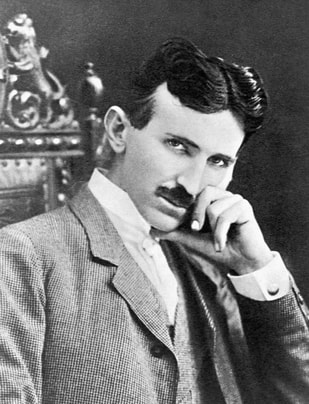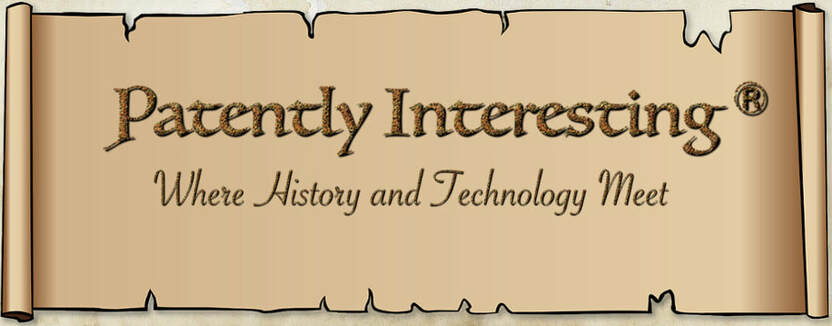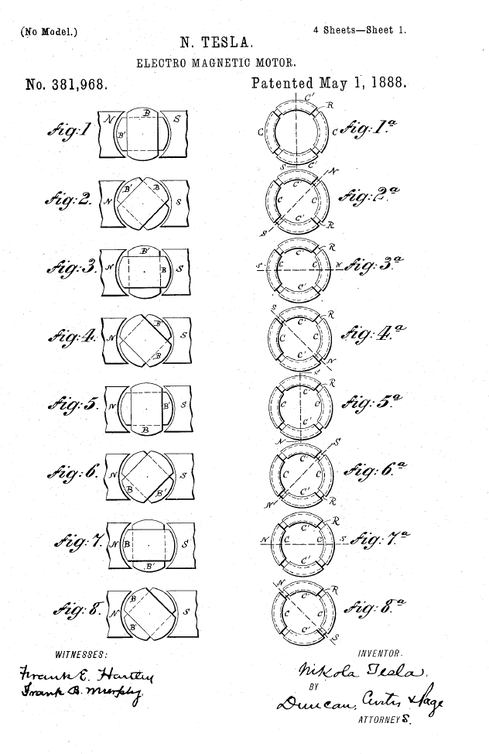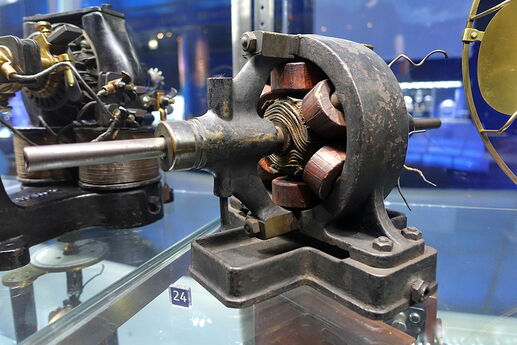 Nikola Tesla
Nikola Tesla
On May 1, 1888, U.S. Patent No.: 381,968 for "Electro Magnetic Motor" issued to Nikola Tesla. In the patent, Tesla disclosed the construction of his alternating current (AC) motor, which is considered one of the most important inventions of all time. While the '968 patent is often referred to as being the patent for the first practical AC motor, the claims of the '968 patent are, in fact, directed to a combination of an AC generator and an AC motor, wherein current from the generator is supplied to the motor to shift its poles. It was a rather odd way of protecting Tesla's rights in the AC motor, but then again, Tesla was a rather odd man and he considered the use of alternating current to power a motor as being his true invention.
Tesla's idea for the AC motor had its genesis in an incident that occurred while he was a student at the Austrian Polytechnic School in Graz. A professor Poeschl, who taught physics, brought a Gramme dynamo into class one day and demonstrated its operation. The dynamo produced direct current (DC) using a commutator that created an excessive amount of sparking. Seeing how inefficient the dynamo was, Tesla intuitively knew that the commutator was unnecessary, and that AC could be used instead of DC to provide power to devices, such as motors. Tesla made his opinion known to the class and was instantly met with derision from professor Poeschl, who spent the rest of the class making fun of Tesla. From that point forward, Tesla was determined to find a way to eliminate the commutator and use AC directly without any intermediary devices.
Tesla obsessed over the issue of harnessing AC for the next four years. Finally, in February of 1882, he had his epiphany. While walking at sunset with his friend Antal Szigeti in a park in Budapest, reciting stanzas from Goethe's Faust, Tesla suddenly had a vision in his mind of the principles of his AC motor system. He grabbed a stick and drew diagrams of the operation of the system in the sand. These diagrams would later appear in the '968 patent as Figs. 1-8a.
What Tesla had invented was a generator having an armature core wound with two coils B B' that was rotated between two field magnets to produce two AC currents that were ninety degrees out of phase with each other. These two currents were supplied to the motor. One AC current was carried by wires to a pair of coils C C of the motor and the other AC current was carried by wires to coils C' C' of the motor. In the motor, the coils C C C' C' were arranged around the circumference of an iron ring R, with the coils C C being arranged diametrically opposite each other and the coils C' C' being arranged diametrically opposite each other. A magnetic disk D mounted on a shaft was rotatably disposed inside the ring R.
The provision of the out-of-phase AC currents to the coils C C C' C' created a rotating magnetic field. This rotating magnetic field, in turn, induced an electric current in the magnetic disk D, which produced its own magnetic field that opposed the rotating magnetic field. The interaction between the two magnetic fields caused the magnetic disk D to rotate. Since the motor ran due to the induction of electric current in the magnetic disk D, this type of motor has since become known as an AC induction motor.
A year after his epiphany, Tesla built a model of his AC induction motor, while he was working in France. However, he did not pursue patent protection for his invention until late 1887, after he had immigrated to the U.S. On October 12, 1887, Tesla filed the application for the '968 patent and soon after filed six more patent applications for various features of his AC motor system. All seven applications issued as patents on May 1, 1888. Also in May of 1888, Tesla delivered his seminal lecture to the American Institute of Electrical Engineers, entitled "A New System of Alternating Current Motors and Transformers" in which he described in very simple and lucid terms the operation of his AC inductive motor system.
After reading Tesla' seminal lecture, George Westinghouse became interested in Tesla's motor system. At the time, George Westinghouse was developing an AC power system for his lighting system, which was in competition with Thomas Edison's DC lighting system. Westinghouse quickly negotiated a deal with Tesla, pursuant to which Westinghouse purchased Tesla's patents for $20,000in cash and $50,000 in notes, payable in three installments. Westinghouse also agreed to pay Tesla royalties of $2.50 per AC horsepower produced by each Tesla motor.
Westinghouse's purchase of Tesla's AC motor system kicked off a full-scale industrial war between Westinghouse and Thomas Edison, who advocated DC power systems. The war would decide whether AC or DC would become the dominant mode of power supply in the U.S.
Tesla's idea for the AC motor had its genesis in an incident that occurred while he was a student at the Austrian Polytechnic School in Graz. A professor Poeschl, who taught physics, brought a Gramme dynamo into class one day and demonstrated its operation. The dynamo produced direct current (DC) using a commutator that created an excessive amount of sparking. Seeing how inefficient the dynamo was, Tesla intuitively knew that the commutator was unnecessary, and that AC could be used instead of DC to provide power to devices, such as motors. Tesla made his opinion known to the class and was instantly met with derision from professor Poeschl, who spent the rest of the class making fun of Tesla. From that point forward, Tesla was determined to find a way to eliminate the commutator and use AC directly without any intermediary devices.
Tesla obsessed over the issue of harnessing AC for the next four years. Finally, in February of 1882, he had his epiphany. While walking at sunset with his friend Antal Szigeti in a park in Budapest, reciting stanzas from Goethe's Faust, Tesla suddenly had a vision in his mind of the principles of his AC motor system. He grabbed a stick and drew diagrams of the operation of the system in the sand. These diagrams would later appear in the '968 patent as Figs. 1-8a.
What Tesla had invented was a generator having an armature core wound with two coils B B' that was rotated between two field magnets to produce two AC currents that were ninety degrees out of phase with each other. These two currents were supplied to the motor. One AC current was carried by wires to a pair of coils C C of the motor and the other AC current was carried by wires to coils C' C' of the motor. In the motor, the coils C C C' C' were arranged around the circumference of an iron ring R, with the coils C C being arranged diametrically opposite each other and the coils C' C' being arranged diametrically opposite each other. A magnetic disk D mounted on a shaft was rotatably disposed inside the ring R.
The provision of the out-of-phase AC currents to the coils C C C' C' created a rotating magnetic field. This rotating magnetic field, in turn, induced an electric current in the magnetic disk D, which produced its own magnetic field that opposed the rotating magnetic field. The interaction between the two magnetic fields caused the magnetic disk D to rotate. Since the motor ran due to the induction of electric current in the magnetic disk D, this type of motor has since become known as an AC induction motor.
A year after his epiphany, Tesla built a model of his AC induction motor, while he was working in France. However, he did not pursue patent protection for his invention until late 1887, after he had immigrated to the U.S. On October 12, 1887, Tesla filed the application for the '968 patent and soon after filed six more patent applications for various features of his AC motor system. All seven applications issued as patents on May 1, 1888. Also in May of 1888, Tesla delivered his seminal lecture to the American Institute of Electrical Engineers, entitled "A New System of Alternating Current Motors and Transformers" in which he described in very simple and lucid terms the operation of his AC inductive motor system.
After reading Tesla' seminal lecture, George Westinghouse became interested in Tesla's motor system. At the time, George Westinghouse was developing an AC power system for his lighting system, which was in competition with Thomas Edison's DC lighting system. Westinghouse quickly negotiated a deal with Tesla, pursuant to which Westinghouse purchased Tesla's patents for $20,000in cash and $50,000 in notes, payable in three installments. Westinghouse also agreed to pay Tesla royalties of $2.50 per AC horsepower produced by each Tesla motor.
Westinghouse's purchase of Tesla's AC motor system kicked off a full-scale industrial war between Westinghouse and Thomas Edison, who advocated DC power systems. The war would decide whether AC or DC would become the dominant mode of power supply in the U.S.



